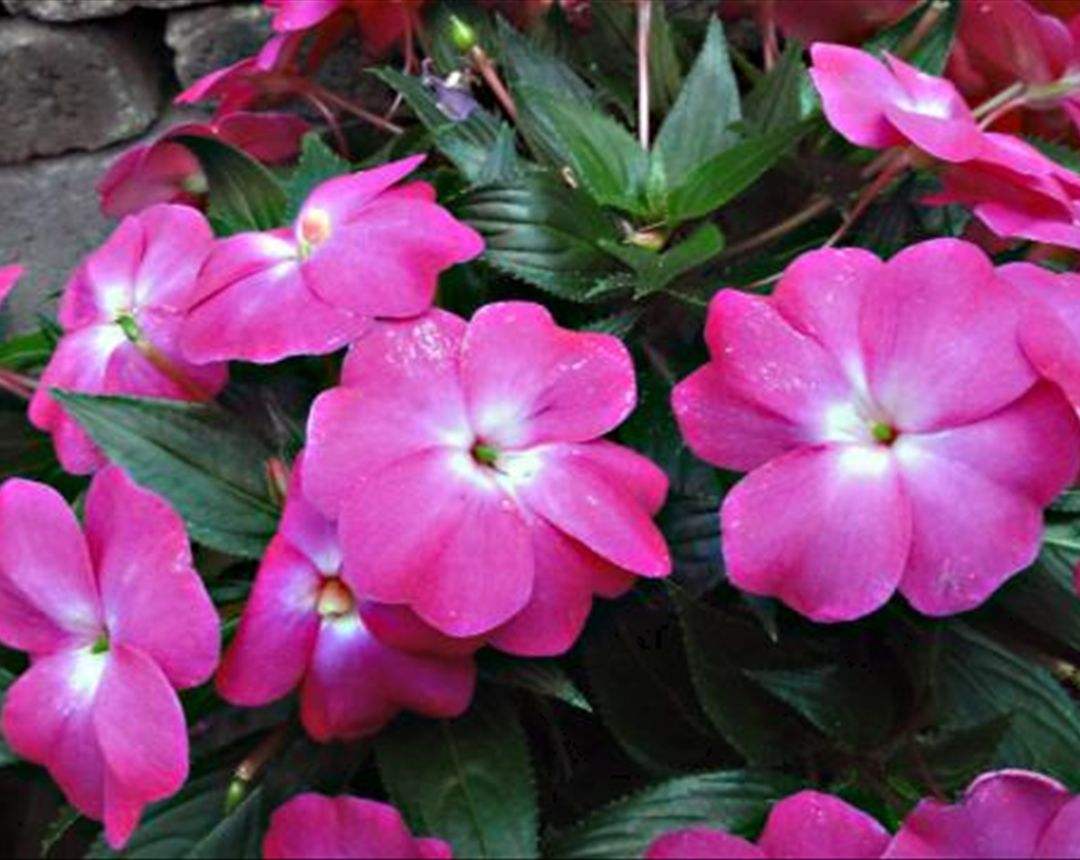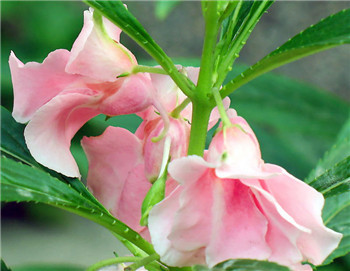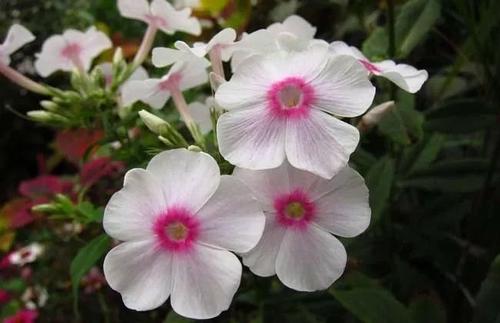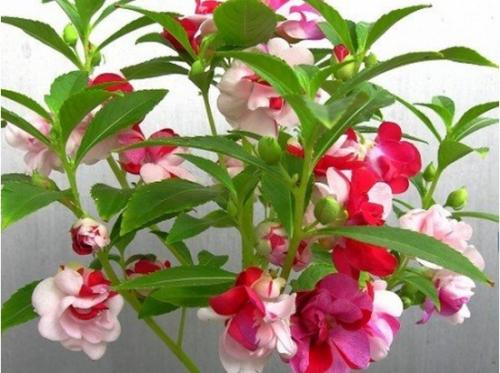Impatiens balsamina L. profile
Written by Maggie
Nov 16 2020

Impatiens balsamina L., is an annual herbaceous flower belonging to the Dicotyledon Class, Ganoderma, Impatiens family, and Impatiens. The whole plant has six parts: roots, stems, leaves, flowers, fruits and seeds. Because its flower head, wings, tail, and feet are all upright like a phoenix, it is also called golden phoenix flower. The body of Impatiens balsamina L. has six parts: root, stem, leaf, flower, fruit and seed. The flowers have various colors, such as pink, scarlet, purple, pink and purple. The petals or leaves are crushed, and the nails are wrapped with leaves. They can be dyed with bright red. They are very beautiful and very popular with girls.
Impatiens balsamina L. picture

Morphological characteristics of Impatiens balsamina L.
Impatiens balsamina L. is an annual herb, 60-100 cm tall. The stem is stout, fleshy, erect, unbranched or branched, glabrous or sparsely pilose when young, the base diameter can reach 8 mm, with many fibrous roots, and the lower nodes are often swollen.
leaf
The leaves are alternate, and the lowermost leaves are sometimes opposite; the leaves are lanceolate, narrowly elliptic or oblanceolate, 4-12 cm long and 1.5-3 cm wide, apex or acuminate, wedge-shaped at the base, with sharp serrations, There are often several pairs of sessile black glands toward the base, both sides are glabrous or sparsely pilose, with 4-7 pairs of lateral veins; petioles are 1-3 cm long, with shallow grooves on top, and several pairs of stalked glands on both sides .
flower
Flowers are solitary or 2-3 clusters in leaf axils, without total pedicel, white, pink or purple, single or double; pedicel is 2-2.5 cm long, densely pilose; bracts are linear, located at the base of pedicel; Lateral sepals 2, ovate or ovate-lanceolate, 2-3 mm long, deep scaphoid, 13-19 mm long, 4-8 mm wide, pilose, 1-2.5 cm long at base Inwardly curved; flag petals are round, pocket-shaped, slightly concave at the apex, middle ribs on the back with narrow keel-like protrusions, apex with small tips, wing petals with short stems, 23-35 mm long, 2-lobed, small lower lobes, Obovate-oblong, upper lobes nearly round, apex 2-lobed, outer edge with small ears near base; stamens 5, filaments linear, anthers ovoid, apex obtuse; ovary fusiform, densely pilose. Capsules are broad and fusiform, 10-20 mm long: pointed at both ends, densely pilose.
seed
The seeds are mostly round, 1.5-3 mm in diameter, dark brown. Flowering from July to October.
Impatiens balsamina L. is shaped like a butterfly, with colors of pink, scarlet, purple, white and yellow, and gold. Some varieties can have petals of several colors on the same plant.
Growth habits of Impatiens balsamina L.
Impatiens balsamina L. is sun-loving, but afraid of humidity, heat-resistant and cold-resistant. The sunny topography and loose and fertile soil can also grow in poorer soil.
Impatiens balsamina L. has strong survivability, good adaptability, and generally has few pests. If powdery mildew occurs due to high temperature and high humidity, it can be sprayed with 800 times liquid of 50% thiophanate-based wettable powder to prevent it. If leaf spot disease occurs, it can be controlled with 50% carbendazim wettable powder 500 times solution. The main pest of Impatiens balsamina L. is the red hawk moth, whose larvae gnaw on the leaves of impatiens. If this pest is found, it can be manually captured and eliminated.

Geographical distribution of Impatiens balsamina L.
Impatiens balsamina L. is native to China and India. It is widely cultivated in gardens throughout China and is a common ornamental flower. Impatiens balsamina L. is cultivated all over the north and south of China. The medicinal materials are mainly produced in Jiangsu, Zhejiang, Hebei, Anhui and other places.
The main value of Impatiens balsamina L.
Medicinal value
The flowers and leaves of Impatiens balsamina L. are commonly used in folk to dye nails. Stems and seeds are used as medicine. The stem has the effects of dispelling rheumatism, promoting blood circulation, and relieving pain. It is used to treat rheumatic joint pain and unfavorable flexion and extension; the seeds have the effect of softening and eliminating accumulation. They are used to treat choking of the diaphragm, bone throat, abdominal mass, and amenorrhea.
Ornamental value
Gardens throughout our country are widely cultivated Impatiens balsamina L. and are common ornamental flowers.

Use value
Staining
Impatiens balsamina L. has a natural reddish brown pigment. Middle Easterners planted this plant for a long time and used its juice to dye nails and modify themselves. According to records, Cleopatra used Impatiens balsamina L.’s seeds to dye her hair. The famous Indian body painting is also dyed with it.
Snake repellent
According to news reports: According to Huang Yongzhao, a researcher from Chongqing Natural History Museum, a Chinese expert on amphibians and reptiles, Impatiens balsamina L. can also repel snakes.
Latest Updated
- Benefits of Bugleweed - 7 Science-backed Health Benefits
- Bugleweed Dangers & Side Effects - Is It Poisonous?
- How to Plant Evergreen Trees - What You Should Know
- When to Plant Evergreens - Grow Guide for Evergreen Trees
- 12 Wonderful Evergreen Shrubs for Your Garden
- 12 Popular Evergreen Plants with Pictures for Beginners
- When And How To Prune A Lilac Bush Like a Pro
- How to Grow & Care for Lilac Vine (Hardenbergia Violacea)
- Japanese Lilac Tree (Syringa Reticulata) Care & Propagation Guide
- Shumard Oak Pros and Cons - What to Know
Popular Articles
- Winter maintenance of Antirrhinum Majus
- How to Grow Terminalia Mantaly Tree
- How to Grow and Care for Crossostephium Chinense
- How to grow Antirrhinum Majus in spring
- Peristeria Elata (Dove Orchid) Profile: Info & Care Guide
- Underwatered Snake Plant (Sansevieria Trifasciata) - Signs And How To Fix
- How to Care for Brazilian Jasmine Plant (Mandevilla Sanderi)
- How to Grow & Care for Graptopetalum Purple Delight in Summer
- Rosa Chinensis (China Rose): Plant Growing & Care Tips
- How to Care for Baby Sun Rose (Aptenia Cordifolia)